
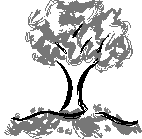 Trees and Forest Study Guide
Trees and Forest Study Guide
Trees and forests are valued for a number of reasons:
The difference between plants and trees:
Trees |
Plants |
|
|
Trees and forests are affected by the living parts of the forest environment (biotic) and the non-living parts of the environment (the abiotic). Some examples are
Biotic (living)
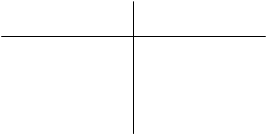
Sunlight plants
Climate animals
Rocks microorganisms
Water
Wind
Soil
There are many different types of plants and animals that live in the forest. These include:
Grass Mouse Snake Hawk
(producer) (primary (secondary (tertiary
consumer) consumer) consumer)

The nutrient cycle shows how nutrients flow throughout an ecosystem. The nutrient cycle starts with the producer and ends with the decomposers.
Common decomposers include:
The water cycle describes how water moves through the forest ecosystem. Some points to the water cycle are:
If one part of an ecosystem is threatened or does not function, the rest of the forest ecosystem is affected
Example: If a forest is clear-cut, the soil will loose valuable nutrients. It will run off into a river if there is a heavy rain because nothing is able to keep the soil anchored. The stream may become full of silt and affect the fish and insects that use the river. The animals (consumers) that had used the forest before it was clear-cut will have to find new sources of food and protection.
Trees and plants produce oxygen and sugars in a process called photosynthesis. The trees take in carbon dioxide, water and energy from the sun and produce oxygen and sugar. Photosynthesis takes place in the leaves.
Trees can be classified into 2 main types- coniferous and deciduous.
Deciduous trees |
Coniferous trees |
|
|
To classify trees, we can look at several different characteristics. A dichotomous key (classification key) can help us to find the name of the tree.
To classify leaves, we can look at:
To classify bark, we can look at
We can classify trees by their general shape or silhouette.
We can look at the growth patterns of a tree by looking at tree cookies. We can look at the pattern of the rings and determine:
Humans have used the forest in a number of ways in the past and present and will in the future. These have included logging, recreation and might include some new future use.
Humans have enhanced the forest through protection of areas (National and Provincial parks) and have set up laws that protect animals and plants in the forest.
Humans have threatened the forests by over logging, cutting down areas for new house construction, and not taking care of the forest when using it for recreation.
Trees and Forest Vocabulary
Forest- tress and their environment
Succession- the changes in a forest over time
Deciduous Trees- loose their leaves in the fall
Coniferous Trees – evergreen trees- do not loose their leaves in the fall
Upper Canopy- top of the forest formed by leaves and branches of the tallest tress. Birds (owl, orioles, and insects (aphids, tent caterpillars) make homes here.
Understory- level below the canopy. Smaller trees and larger shrubs. Provides sheltered space for birds and small mammals (squirrels, woodpeckers, insects)
Underbrush- level before the forest floor. Ferns, wildflowers stem plants, insects, butterflies, small mammals like mice, larger mammals like deer, skunks.
Forest Floor- bottom level of the forest- groundcover and soil: where you find decomposers (worms, bacteria, soil insects, tree roots) and dead materials.
Transpiration- moisture given off by plants through their leaves
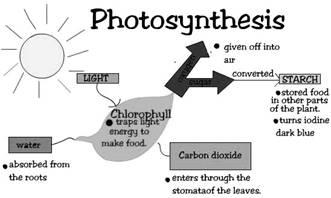
Photosynthesis- plants convert sunlight, water, and carbon dioxide into oxygen and nutrients (sugars) for the plant to use.
Chlorophyll- part in the plant cell that makes the plant green; needed for photosynthesis.
Stomata- tiny openings on the underside of a plant’s leaves. Place where gases are exchanged
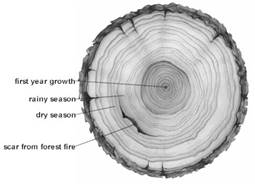 Examining a Tree
Examining a Tree
Tree cookie- cross section of a tree. Helps to show the life story of a tree.
Leaf- the flat green part of a plant that makes food (photosynthesis)
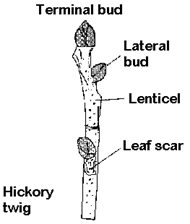 Leaf Scar- the scar left by a leaf of deciduous trees when the leaf falls off in the autumn.
Leaf Scar- the scar left by a leaf of deciduous trees when the leaf falls off in the autumn.
Girdle- a scar on the branch of a tree showing one year of the branches growth.
Bark- outside covering of a tree. Function – protection and insulation
Cambium- inside of the trunk where the tree grows. Function- to produce new wood and bark
Sapwood (xylem)- the softer living part of the wood around the heartwood. Function- to move sap from the roots to the leaves
Phloem- the inner part of the tree. Function- carries food from the branches and leaves to the roots
Heartwood- the older dead part of wood near the middle of a tree. Function- for support
Pith- central core of the tree
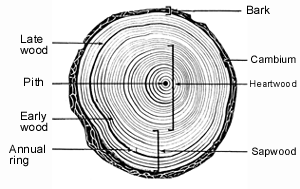
Ecosystem- interactions that link the living things and the non-living things in an environment.
Habitat- the natural home of an organism
Abiotic- the non-living parts of the environment. Soil, air, water, sunlight, temperature, wind, terrain.
Biotic- the living parts of the environment. Plants, animals and microorganisms.
Producer - plants that produce their own food through photosynthesis
Consumer- organisms that must get their food from their environment (do not make their own)
Primary consumer- eats producers
Secondary consumer- eats primary consumer
Tertiary consumers- eat secondary consumers
Decomposers- feed on dead materials and put nutrients back into the soil
Food chain- the movement of food energy through the different levels of consumers. Single chain.
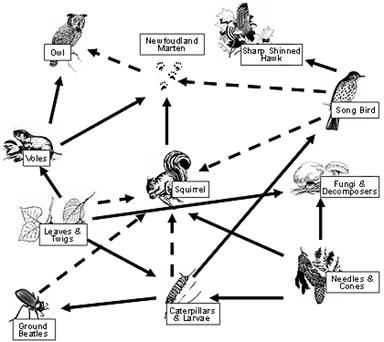
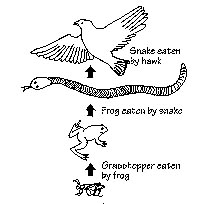
Food web- a lot of food chains intertwined forming a network of interactions.
Nutrient cycle- how nutrients are cycled between the biotic and abiotic parts of the environment.
Source: http://gp.lethsd.ab.ca
Web site to visit: http://gp.lethsd.ab.ca/documents/homework/Trees%20Study%20Guide.doc
Author of the text: not indicated on the source document of the above text
If you are the author of the text above and you not agree to share your knowledge for teaching, research, scholarship (for fair use as indicated in the United States copyrigh low) please send us an e-mail and we will remove your text quickly. Fair use is a limitation and exception to the exclusive right granted by copyright law to the author of a creative work. In United States copyright law, fair use is a doctrine that permits limited use of copyrighted material without acquiring permission from the rights holders. Examples of fair use include commentary, search engines, criticism, news reporting, research, teaching, library archiving and scholarship. It provides for the legal, unlicensed citation or incorporation of copyrighted material in another author's work under a four-factor balancing test. (source: http://en.wikipedia.org/wiki/Fair_use)
The information of medicine and health contained in the site are of a general nature and purpose which is purely informative and for this reason may not replace in any case, the council of a doctor or a qualified entity legally to the profession.
The following texts are the property of their respective authors and we thank them for giving us the opportunity to share for free to students, teachers and users of the Web their texts will used only for illustrative educational and scientific purposes only.
All the information in our site are given for nonprofit educational purposes
The information of medicine and health contained in the site are of a general nature and purpose which is purely informative and for this reason may not replace in any case, the council of a doctor or a qualified entity legally to the profession.
www.riassuntini.com